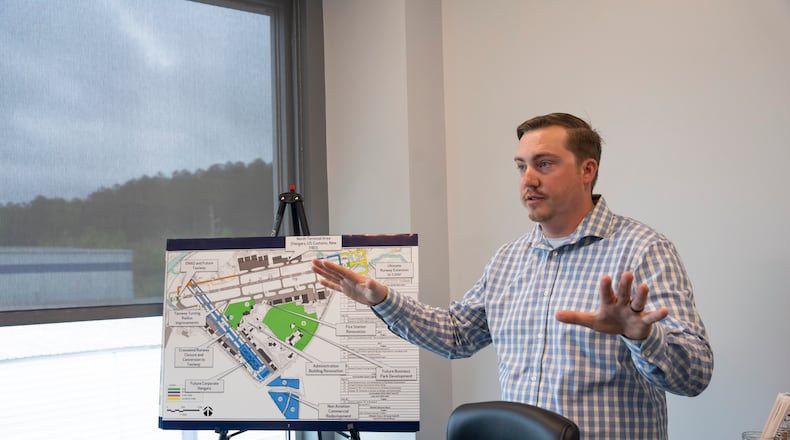Samir Abdullahi says metro Atlanta has two front doors.
There is downtown, with Mercedes-Benz Stadium, State Farm Arena and the future Centennial Yards for millions of everyday visitors.
And there is another used by an elite group of big corporations and billionaire owners of private jets — the Fulton County Executive Airport. That door leads out onto Fulton Industrial Boulevard, part of which is the last remaining unincorporated area of the county.
The public front door is getting extensive redevelopment. But the elite entrance needs work, said Abdullahi, director of Select Fulton, the county’s economic development office.
That work is already underway, and some of it will be visible Thursday when officials from the county, city of South Fulton, and Boulevard Community Improvement District gather for the demolition of the low-budget Executive Inn and Super Inn that officials say was a magnet for crime.
Fulton officials are calling it a “pivotal moment” in the county’s Renew the District initiative, making it safer and primed for redevelopment.
The county airport, built in 1949, sees more than 8,000 annual takeoffs and landings, up from 3,000 a few years ago.
Corporate jets make up more than three-quarters of flight operations, Abdullahi said. Consultants estimate the number of aircraft based at the county airport will increase nearly 40% by 2040.
But when new private jets take off for international trips, they can’t do it with a full tank. The county runway isn’t long enough for the largest late-model jets to get airborne fully loaded, Abdullahi said. Instead they have to hop to Hartsfield-Jackson International Airport to top off their fuel.
So Fulton County wants to lengthen its runway and provide more hangar space for corporate jets. That will be essential when Atlanta hosts the World Cup in 2026, Abdullahi said.
“We’ve got entire countries calling saying: ‘Hey, we’re Brazil, we’re bringing five or six jets,’” he said. “We’re going to have them lined up out there.”
Credit: Olivia Bowdoin
Credit: Olivia Bowdoin
The FAA gave the airport master plan final approval in January. It calls for extending the main runway by 305 feet, to 6,101 feet. That will accommodate the Gulfstream G550/650, a twin-engine jet that’s 100 feet long and weighs nearly 50 tons fully loaded.
A later phase would extend the runway to 7,000 feet. After the main runway is lengthened, plans call for converting the shorter crosswind runway to a taxiway. That would free up 100,000 square feet of room for about seven new hangars, Airport Manager Jonathan Gauthier said.
Lack of hangar space is costing the airport customers, Abdullahi said. One company moved its three jets to South Carolina, and another company with six jets is considering the same, he said.
Federal funds would be expected to cover 90% of the essential aviation parts of the plan, with the state paying another 5%, Gauthier said.
The airport upgrade will likely take more than a decade; funding is already available for a customs building, and a new fire station is under construction as part of the airport’s administrative offices. The old control tower, now unused, will be torn down and replaced with offices and restaurants, said David Clark, county director of Public Works, which oversees the airport.
Funding for some airport improvements will come from leasing airport land to UPS for a warehouse. That provides $1.5 million a year, increasing the airport’s total annual revenue to about $4 million, Clark said. That money stays at the airport, so county tax dollars won’t have to be spent on improvements, he said.
Renew the District
Hand in hand with airport improvement goes redevelopment of the adjacent Fulton Industrial Boulevard corridor and Interstate 20 interchange.
Total price for the Renew the District initiative could be close to $200 million, about half public — mostly federal runway funding — and half private, drawn by airport and corridor improvements, Abdullahi said.
The county has already put millions into cleaning up the interchange. Several low-budget hotels attracted drugs and general crime, and that spilled over around the executive airport itself, damaging the area’s appeal, Abdullahi said.
“You can’t change the story without kind of fixing that element,” he said.
Credit: Olivia Bowdoin
Credit: Olivia Bowdoin
Around 2020, the county bought seven properties there, a total of 15.2 acres, for $15 million — using a straw buyer to avoid paying “big bucks,” Abdullahi said. Even so the owner of the Economy Hotel held out, he said.
The Executive and Super Inn sites are among the purchases. The county will seek developers for those properties, which may become warehouses or truck parking.
The shuttered Knights Inn, a closed McDonald’s and gas station are the most attractive sites for redevelopment because they have frontage on Fulton Industrial, he said.
Shuttering those hotels brought crime in the area way down, said Gil Prado, Boulevard CID executive director.
“Things started really changing from that point on,” he said. Site occupancy went from about 50% in some parts of the district to 95%, Prado said.
Some old properties are being redeveloped, but the focus is on developing long-vacant spots, he said.
Scope and aid
The Fulton Industrial Boulevard corridor is larger than the remaining unincorporated area, Abdullahi said. It spills into South Fulton to the south and a small part of Atlanta to the north. Altogether, it covers about 12.7 square miles, or 2.4% of the county.
The corridor has 55 million square feet of industrial property, one of the largest concentrations in the Southeast and a third of all industrial space in Fulton County, Abdullahi said.
Directly and indirectly, the district supports more than 77,000 jobs, generating more than $31.1 billion in economic output, a 2023 economic analysis from the CID says.
The district has more than 1,000 businesses, contributing $182 million a year in taxes, licenses and fees to 10 government entities. All but $60 million of that goes to the state, the analysis says. That includes $17 million to county schools, and $13 million each to Fulton County and the city of South Fulton.
Credit: Olivia Bowdoin
Credit: Olivia Bowdoin
As a counterpart to federal assistance at the airport, the county needs help on the road corridor from the Boulevard CID, Abdullahi said.
After 70 years, the industrial district had gotten shabby, with a crime problem and neglected maintenance, Prado said.
“The grass was three feet tall in the median, litter everywhere,” he said. Industrial tenants threatened to leave if local officials didn’t do anything, and some did move out. Major property owners and the county formed the CID in 2010 to deal with public safety, landscaping, infrastructure and economic development, Prado said.
An assessment on property owners raises about $2 million a year for improvements, he said. That is used to leverage further investments, such as revamping the intersection with Donald Lee Hollowell Parkway. The CID put in $20,000 as a match for $3.5 million in other funding, Prado said. In 14 years, the CID’s financial commitment has attracted about $46 million that way, he said.
“A lot of it is road improvement projects, partnerships with GDOT and the Atlanta Regional Commission,” Prado said.
One of the CID’s first projects was to upgrade the I-20 interchange with landscaping, lights, signs, sculptures and sidewalks.
“We knew that was the front door of the district,” Prado said.
City interest
Abdullahi said the corridor doesn’t need extensive new infrastructure. But the city of South Fulton is on board with Renew the District.
The legislature annexed 7.7 miles of Fulton Industrial, from Campbellton Road to Interstate 20, into South Fulton in 2021. No further annexation is planned, according to the city.
City officials are working with county agencies and the Boulevard CID to clear blighted properties, landscape medians, and coordinate public safety efforts in the area, South Fulton Councilwoman Catherine Rowell said. South Fulton’s Public Works Department is overseeing the repaving of 15 roads off Fulton Industrial, she said.
Credit: Olivia Bowdoin
Credit: Olivia Bowdoin
South Fulton rezoned the former gas station and McDonald’s from industrial to commercial, preparing those sites for “appropriate commercial uses,” according to the city. The hotel sites haven’t been rezoned yet.
City code enforcement isn’t specifically targeting properties on Fulton Industrial, but there are several open violations in the area, according to the city.
Showing its commitment to the initiative, South Fulton bought the former industrial building at 4715 Frederick Drive and turned it into a city administration office, Rowell said.
About the Author
Keep Reading
The Latest
Featured







